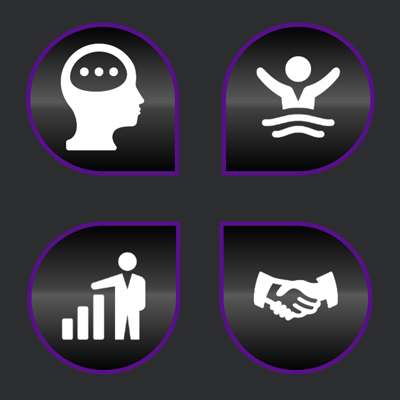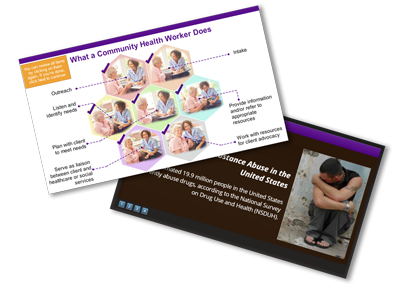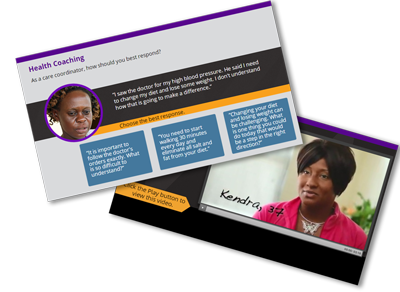The 1199SEIU Training and Employment Funds needed a redesign of their CHW training curriculum. Their training content and methodology were outdated, and no technology was used to deliver training. Here I present the Instructional Design process for this project. I also present the eLearning Development for this project in my portfolio.
Project Background

Community Health Workers (CHWs) provide services and support to enhance the physical health of patients suffering from chronic illness. They are are frontline public health workers who are trusted members of and/or have an unusually close understanding of the community they serve. CHWs also build individual and community capacity by increasing health knowledge and self-sufficiency through a range of activities such as outreach, community education, informal counseling, social support and advocacy.
Since CHWs typically reside in the community they serve, they have the unique ability to bring information where it is needed most. They can reach community residents where they live, eat, play, work, and worship. CHWs are frontline agents of change, helping to reduce health disparities in underserved communities.
This organization needs a curriculum of courses designed to provide CHWs with the specific skills they need to conduct the tasks and accomplish the roles that have come to describe the CHW practice. The curriculum should integrate learning technologies for easier access and for data collection purposes.
Expected Outcomes
Among the many known outcomes of CHWs’ service are the following:
- Improved access to health care services.
- Increased health and screening.
- Better understanding between community members and the health and social service system.
- Enhanced communication between community members and health providers.
- Increased use of health care services.
- Improved adherence to health recommendations.
- Reduced need for emergency and specialty services.
The curriculum focuses on the major public health issues in the areas where the CHWs will be reaching out to the community. It was determined by research that the areas in NYC where the CHWs will work have high numbers of new cases of hypertension, heart disease, HIV and depression. The curriculum will address prevention and treatment education on these and other common preventable and treatable health conditions. Additionally, the curriculum is in alignment with the CHW Core Competencies outlined by the US Department of Health. The competencies emphasize communication, organization, documentation, assessment and service coordination skills.
My Role in the Project
- Project Manager: I coordinated the timelines, resources, SMEs, and budget for the project.
- Instructional Designer: I redesigned the updated curriculum, with the input of Health Care professionals. I used my experience in instructional design for adult learners for community-oriented initiatives.
- Course Developer: I developed 13 of the 25 courses, and I coordinated the development of the rest of the modules with an outsourced vendor.
- Script Writer: I wrote the content, based on the materials provided to me by the content owner, and based on the feedback of health professionals in charge of delivering the ILT portion of the curriculum.
- Visual Designer: I designed and developed the theme and the overall look and feel of the courses. Some of the photos and all the videos were supplied by the client.
- Translator: Portions of the included videos that were in Spanish were translated into English by me.
Instructional Design
Considerations in the creation of the CHW curriculum

The program combines classroom instruction with on-the-job learning. Significant evidence shows that appropriate personal qualities in a CHW candidate are preferred by CHW employers as recruitment criteria - even more preferred than academic achievement. Consequently, acquisition of knowledge is important but it's NOT the dominant focus of the program.
As per recommendations of the CHW Network of NYC, the primary focus of the CHW curriculum is empowerment and development for individuals, families, and communities. The training recommendations directly address the skills necessary to conduct the CHW scope of practice and the stated needs of both CHWs and their employers. The recommendations include methodology with deep roots in adult learning methods and humanistic psychology.
In simpler words, the CHW curriculum is not overscrupulous over knowing obscure facts and details. Instead, it's aimed at training CHW candidates to assume responsibility for their own through understanding their community's health problems and the challenges that influence them.

The current content of the course will be revised and updated to ensure it meets with the following criteria:
- Comprehensive and evidence-based. The materials are based on data from reputable research on effective approaches to preventing and controlling several health conditions' risk factors and to promoting healthy behaviors.
- Adequate for adult education, and at the level of literacy expected of the recipients of the learning. The format of these materials is based on research about how adults learn. The materials have activities that get CHWs to work with and motivate each other.
- Culturally appropriate. The materials showcase the way each ethnic community in the targeted areas engage in physical activity, healthy habits, food preparation, and overall wellness.
- Flexible. CHWs may use one or more sets of the accompanying materials or may combine them in a way that best addresses their community’s unique needs.
Curriculum Goals
Provide CHWs with creative strategies, materials, and tools for training, educating, and changing lifestyle behaviors so CHWs can be active promoters of health in their community. Such strategies will significantly contribute in addressing health disparities in the communities most impacted by several health issues.
Curriculum Objectives
- Identify professional boundaries of a Community Health Worker
- Identify and get to know the target community
- Identify the various barriers to outreach and strategies to overcome barriers to outreach
- Use technology and social media for outreach
- Apply strategies to address cross-cultural communication barriers
- Prioritize activities in relationship to patient care and competing demands
- Explain the relevance of health disparities and social determinants for patient navigation
- Use appropriate techniques to document patient encounters
- Use assessment tools to identify patient or individual needs
- Develop a directoy of internal and community-based supports and resources
- Prioritize and address barriers to care that result in better outcomes
Content Curation and Updates

The existing curriculum content requires updates in the following areas:
- Culturally competent language - The current curriculum uses outdated language when referring to certain underserved communities. That was particularly evident when referring to the LGBTQ+ community, however, several terms around mental health also required revision.
- Statistics and health disparities - As communities develop and evolve, health disparities also change. The arrival of new treatements for certain conditions, the increase (or decrease) of access to health care and support services also change in time, depending on many factors. The current curriculum must reflect the current public health realities in the targeted communities.
- Use and implementation of technology - Technology provides easier access to healthcare to the general public. There are many sources of health information and resouorces that are now accessible online. The current curriculum must include education on how to access online resources, and how to identify reliable health information online.
Design Ideation
It is expected that CHWs provide culturally appropriate health promotion and health education and assistance in accessing medical services and programs. CHWs also provide assistance in accessing non-medical services and programs. Access to instruction, resources and materials for support services to the community is crucial for outreach. Due to the need for availability of information and resources, it was decided that the courses, along with their references and accompanying resources, must be available offline. Also, the courses must be responsive to different devices, not just computers. The courses must contain interactive activities where learners can simulate, apply and practice as they learn. To that end, the courses must use the adequate media for instruction.
The curriculum development phase of the project is provided in detailed in my portfolio.
Results
This approach to instructional design has proven to provide a high level of engagement, faster course completions, and, complemented with live discussions and in-classroom facilitation, it becomes an integral part of a rich education experience.
As of December, 2017, the 1199SEIU Training and Employment Funds has trained over 200 CHWs.

